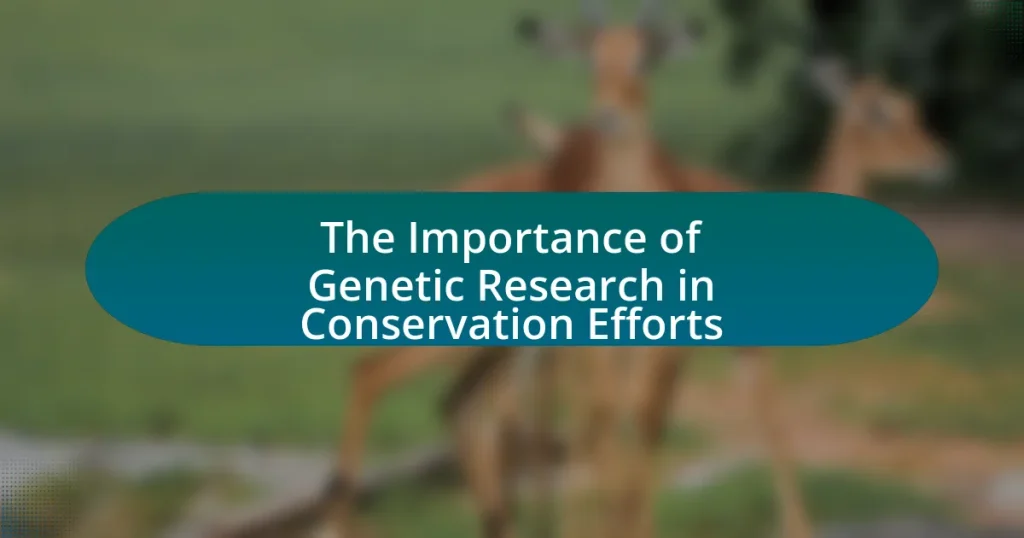Genetic research plays a vital role in conservation efforts by identifying genetic diversity within species, which is essential for their adaptability and survival. This article outlines how genetic analysis informs conservation strategies, enhances biodiversity preservation, and aids in habitat restoration. It discusses the significance of genetic diversity in species resilience, the methods used in genetic research, and the implications for managing endangered species and invasive populations. Additionally, the article addresses the challenges and ethical considerations associated with genetic manipulation in wildlife conservation, emphasizing the need for collaboration and adequate funding to advance research outcomes.

What is the Importance of Genetic Research in Conservation Efforts?
Genetic research is crucial in conservation efforts as it helps identify genetic diversity within species, which is essential for their adaptability and survival. By analyzing genetic variations, conservationists can assess the health of populations, understand their evolutionary potential, and make informed decisions about breeding programs and habitat management. For instance, studies have shown that populations with higher genetic diversity are more resilient to environmental changes and diseases, as evidenced by the recovery of the Florida panther, which benefited from genetic restoration efforts that increased its genetic diversity. This demonstrates that genetic research not only informs conservation strategies but also enhances the effectiveness of these efforts in preserving biodiversity.
How does genetic research contribute to biodiversity conservation?
Genetic research contributes to biodiversity conservation by enabling the identification of genetic diversity within species, which is crucial for their adaptability and survival. This research helps in assessing the genetic health of populations, guiding conservation strategies to maintain or enhance genetic variation. For instance, studies have shown that populations with higher genetic diversity are more resilient to environmental changes and diseases, as evidenced by the work of Frankham et al. (2010) in “Population Viability Analysis in Conservation Planning.” Additionally, genetic tools such as DNA barcoding assist in species identification and monitoring, facilitating the protection of endangered species and their habitats. This integration of genetic data into conservation practices ensures more effective management and preservation of biodiversity.
What role does genetic diversity play in species survival?
Genetic diversity is crucial for species survival as it enhances adaptability to changing environments and resilience against diseases. A diverse gene pool allows populations to better cope with environmental stressors, such as climate change, habitat loss, and emerging pathogens. For instance, studies have shown that species with higher genetic variation, like the European brown bear, exhibit greater survival rates in fluctuating habitats compared to those with low genetic diversity. This adaptability is vital for long-term survival, as it enables species to evolve and maintain healthy populations despite external pressures.
How can genetic research identify endangered species?
Genetic research can identify endangered species by analyzing DNA sequences to determine genetic diversity and population structure. This analysis helps conservationists understand the genetic health of a species, identify distinct populations, and assess their risk of extinction. For example, studies have shown that low genetic diversity can lead to inbreeding and reduced adaptability, which are critical factors in the survival of endangered species. By using techniques such as DNA barcoding and genome sequencing, researchers can accurately identify species and subspecies, even in cases where physical characteristics are ambiguous. This genetic information is essential for developing effective conservation strategies and prioritizing efforts to protect the most vulnerable populations.
Why is genetic research essential for ecosystem management?
Genetic research is essential for ecosystem management because it provides critical insights into the genetic diversity and adaptability of species within an ecosystem. Understanding genetic variation helps in assessing the resilience of populations to environmental changes, diseases, and habitat loss. For instance, studies have shown that ecosystems with higher genetic diversity are more robust and can better withstand disturbances, as evidenced by research indicating that genetically diverse populations of coral reefs are more resilient to climate change impacts. This knowledge allows conservationists to make informed decisions about species protection, habitat restoration, and biodiversity preservation, ultimately leading to more effective ecosystem management strategies.
How does genetic information aid in habitat restoration?
Genetic information aids in habitat restoration by enabling the selection of appropriate plant and animal species that are genetically suited to the local environment. This ensures that restored habitats are resilient and can thrive under current and future environmental conditions. For instance, genetic studies can identify local genotypes that are adapted to specific soil types, climate conditions, and ecological interactions, which enhances the success rate of restoration projects. Research has shown that using locally adapted genetic material can improve survival rates and ecosystem functionality, as evidenced by a study published in “Ecological Applications” by McKay et al. (2005), which demonstrated that native genotypes outperformed non-local ones in restoration efforts.
What are the implications of genetic research on invasive species control?
Genetic research significantly enhances invasive species control by providing insights into the genetic makeup and behavior of these species. This understanding allows for the development of targeted management strategies, such as gene editing techniques like CRISPR, which can potentially reduce the reproductive capabilities of invasive populations. For instance, a study published in the journal “Nature” by Esvelt et al. (2014) demonstrated how gene drive technology could be used to spread genetic modifications through populations of invasive species, thereby controlling their numbers more effectively. Additionally, genetic research aids in identifying vulnerabilities in invasive species that can be exploited for biological control, leading to more sustainable and environmentally friendly management practices.

What methods are used in genetic research for conservation?
Genetic research for conservation employs methods such as DNA sequencing, genetic marker analysis, and population genomics. DNA sequencing allows researchers to identify genetic variations within and between species, which is crucial for understanding biodiversity and evolutionary relationships. Genetic marker analysis, including microsatellites and single nucleotide polymorphisms (SNPs), helps assess genetic diversity and inbreeding levels in populations, providing insights into their viability. Population genomics integrates genomic data to study the genetic structure and adaptive potential of populations, informing conservation strategies. These methods have been validated through numerous studies, demonstrating their effectiveness in guiding conservation efforts and enhancing the management of endangered species.
How do scientists collect genetic data from wildlife?
Scientists collect genetic data from wildlife primarily through non-invasive sampling methods, such as collecting hair, feces, or feathers. These samples contain DNA that can be analyzed to understand genetic diversity, population structure, and evolutionary relationships among species. For instance, a study published in the journal “Molecular Ecology” demonstrated that hair samples from large mammals like bears can yield high-quality genetic information without the need for capturing the animals, thus minimizing stress and risk to wildlife. This approach allows researchers to monitor populations and inform conservation strategies effectively.
What techniques are employed for DNA analysis in conservation?
Techniques employed for DNA analysis in conservation include DNA barcoding, microsatellite analysis, and whole-genome sequencing. DNA barcoding allows for species identification and monitoring biodiversity by analyzing short genetic sequences. Microsatellite analysis provides insights into genetic diversity and population structure by examining specific regions of DNA that vary among individuals. Whole-genome sequencing offers comprehensive genetic information, enabling researchers to assess evolutionary relationships and identify adaptive traits. These techniques are crucial for informing conservation strategies and managing endangered species effectively.
How is genetic data integrated into conservation planning?
Genetic data is integrated into conservation planning by assessing genetic diversity, identifying distinct populations, and informing breeding programs. This integration allows conservationists to prioritize areas for protection, ensuring that genetically diverse populations are maintained, which is crucial for species resilience. For example, studies have shown that populations with higher genetic diversity are better equipped to adapt to environmental changes, as evidenced by research on the Florida panther, where genetic management improved population health and viability.
What technologies are advancing genetic research in conservation?
Next-generation sequencing (NGS) technologies are advancing genetic research in conservation by enabling rapid and cost-effective analysis of genetic material from diverse species. NGS allows researchers to sequence entire genomes, providing insights into genetic diversity, population structure, and evolutionary history, which are critical for effective conservation strategies. For instance, studies utilizing NGS have revealed genetic bottlenecks in endangered species, guiding breeding programs to enhance genetic variability and resilience. Additionally, bioinformatics tools developed alongside NGS facilitate the analysis of large datasets, making it easier to identify genetic markers associated with adaptive traits, thus informing conservation management decisions.
How does genomics enhance our understanding of species adaptation?
Genomics enhances our understanding of species adaptation by providing detailed insights into the genetic variations that enable organisms to survive and thrive in changing environments. Through genomic sequencing and analysis, researchers can identify specific genes associated with adaptive traits, such as resistance to diseases or tolerance to extreme temperatures. For instance, studies have shown that the genomic analysis of the Antarctic icefish revealed unique adaptations that allow it to survive in freezing waters, highlighting how genomic data can pinpoint the genetic basis of adaptation. This understanding is crucial for conservation efforts, as it informs strategies to protect vulnerable species and ecosystems facing rapid environmental changes.
What role do bioinformatics play in analyzing genetic data?
Bioinformatics plays a crucial role in analyzing genetic data by providing computational tools and methods to manage, analyze, and interpret complex biological information. These tools enable researchers to sequence genomes, identify genetic variations, and understand evolutionary relationships among species, which is essential for conservation efforts. For instance, bioinformatics techniques such as genome assembly and annotation allow scientists to reconstruct the genetic makeup of endangered species, facilitating targeted conservation strategies. Additionally, bioinformatics supports the analysis of large datasets generated by high-throughput sequencing technologies, enabling the identification of genetic markers linked to traits important for survival and adaptation in changing environments.

What challenges does genetic research face in conservation efforts?
Genetic research in conservation efforts faces several challenges, including limited funding, ethical concerns, and technical limitations. Limited funding restricts the scope and scale of genetic studies, hindering the ability to conduct comprehensive research necessary for effective conservation strategies. Ethical concerns arise from the manipulation of genetic material, which can lead to debates over the appropriateness of certain interventions, such as gene editing in endangered species. Technical limitations, such as difficulties in obtaining high-quality genetic samples from wild populations and the complexity of analyzing genetic data, further complicate conservation efforts. These challenges collectively impede the advancement of genetic research that is crucial for preserving biodiversity and managing endangered species effectively.
What ethical considerations arise in genetic conservation research?
Ethical considerations in genetic conservation research include the potential for unintended consequences, the rights of indigenous communities, and the implications of genetic manipulation. Unintended consequences may arise from altering genetic material, which can disrupt ecosystems or lead to loss of genetic diversity. The rights of indigenous communities must be respected, as they often hold traditional knowledge and have a vested interest in the conservation of local species. Additionally, genetic manipulation raises concerns about playing a role in evolution, which can lead to ethical dilemmas regarding the natural order and biodiversity. These considerations highlight the need for careful ethical frameworks and guidelines in genetic conservation research to ensure responsible practices.
How do researchers address concerns about genetic manipulation?
Researchers address concerns about genetic manipulation by implementing rigorous ethical guidelines and conducting thorough risk assessments. These protocols ensure that genetic modifications are safe for both the environment and human health. For instance, the National Academy of Sciences emphasizes the importance of transparency in research processes and public engagement to foster trust and understanding. Additionally, researchers often collaborate with regulatory bodies to establish frameworks that govern the use of genetic technologies, ensuring compliance with safety standards and ethical considerations. This approach is supported by studies indicating that well-regulated genetic manipulation can lead to significant conservation benefits, such as the restoration of endangered species and the enhancement of biodiversity.
What are the potential risks of genetic research in wildlife?
The potential risks of genetic research in wildlife include unintended ecological consequences, loss of genetic diversity, and ethical concerns. Unintended ecological consequences can arise when genetically modified organisms interact with natural populations, potentially disrupting ecosystems. For example, the introduction of genetically altered species could lead to competition with native species, resulting in population declines or extinctions. Loss of genetic diversity may occur if genetic research favors certain traits, leading to a homogenization of populations and reducing their ability to adapt to environmental changes. Ethical concerns also emerge regarding the manipulation of wildlife genetics, raising questions about the welfare of individual animals and the moral implications of altering natural processes. These risks highlight the need for careful consideration and regulation in genetic research within wildlife conservation efforts.
How can funding and resources impact genetic research in conservation?
Funding and resources significantly impact genetic research in conservation by determining the scope, quality, and effectiveness of research initiatives. Adequate funding allows for advanced technologies, such as genomic sequencing and bioinformatics tools, which enhance the ability to analyze genetic diversity and population structure in endangered species. For instance, a study published in “Molecular Ecology” by Frankham et al. (2017) highlights that increased financial support leads to more comprehensive genetic assessments, which are crucial for developing effective conservation strategies. Additionally, resources enable collaboration among researchers, conservationists, and policymakers, facilitating the implementation of findings into actionable conservation plans. Thus, the availability of funding and resources directly correlates with the success of genetic research in conservation efforts.
What strategies can be implemented to secure funding for genetic studies?
To secure funding for genetic studies, researchers can implement strategies such as forming collaborations with academic institutions, engaging with non-profit organizations, and applying for government grants. Collaborations with universities can provide access to shared resources and expertise, enhancing the credibility of the research proposal. Non-profit organizations often have specific interests in conservation and may offer grants or funding opportunities aligned with genetic studies. Additionally, government grants, such as those from the National Institutes of Health or the National Science Foundation, are available for research that addresses critical issues in conservation, including genetic diversity and species preservation. These funding sources are essential as they support innovative research that can lead to significant advancements in conservation efforts.
How do collaboration and partnerships enhance research outcomes?
Collaboration and partnerships enhance research outcomes by pooling diverse expertise and resources, leading to more comprehensive and innovative solutions. For instance, interdisciplinary collaborations in genetic research have resulted in significant advancements in conservation strategies, such as the successful application of genetic techniques to identify and preserve endangered species. A study published in “Conservation Biology” by Frankham et al. (2017) highlights that collaborative efforts among geneticists, ecologists, and conservationists have improved the genetic management of populations, thereby increasing their viability and resilience. This synergy not only accelerates the research process but also ensures that findings are more applicable and impactful in real-world conservation efforts.
What best practices should be followed in genetic research for conservation?
Best practices in genetic research for conservation include ensuring genetic diversity, utilizing non-invasive sampling methods, and applying advanced genomic techniques. Ensuring genetic diversity is crucial as it enhances population resilience and adaptability, which is supported by studies showing that populations with higher genetic variation are more likely to survive environmental changes. Non-invasive sampling methods, such as collecting hair or fecal samples, minimize stress on wildlife and reduce the risk of habitat disturbance, as evidenced by successful applications in monitoring endangered species. Advanced genomic techniques, including whole-genome sequencing, provide comprehensive insights into genetic health and evolutionary potential, which have been demonstrated to inform conservation strategies effectively.

